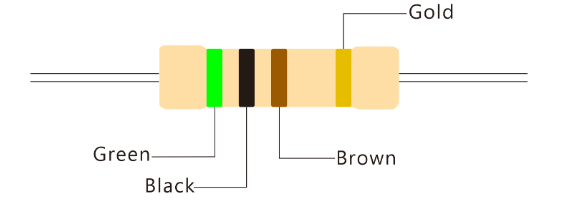A 500 Ohm resistor is an electronic component with a resistance value of 500 ohms. Resistors are passive electrical components that impede the flow of electric current through a circuit. The resistance value of a resistor is measured in ohms (symbol: Ω) and determines how much the resistor resists the flow of current.

Here are some key points about a 500 Ohm resistor:
Characteristics of a 500 Ohm Resistor:
-
Resistance Value:
- A 500 Ohm resistor has a resistance value of 500 ohms. This means that when a voltage difference is applied across the resistor, it will allow a current of I = V/R amperes to flow through it, where V is the voltage and R is the resistance.
-
Color Code:
- In through-hole resistors, the color bands on the resistor body indicate the resistance value. For a 500 Ohm resistor, the color code might be specific to represent this value.
-
Power Rating:
- Resistors are also rated for power dissipation, typically measured in watts. A 500 Ohm resistor's power rating indicates how much power it can safely dissipate without overheating or being damaged.
-
Applications:
- Resistors are used in a wide range of electronic circuits for various purposes, such as current limiting, voltage division, signal conditioning, and impedance matching.
Usage of a 500 Ohm Resistor:
-
Current Limiting:
- In some circuits, a 500 Ohm resistor might be used to limit the amount of current flowing through a specific component or part of the circuit.
-
Voltage Division:
- Resistors are commonly used in voltage divider circuits to create reference voltages or to interface with analog-to-digital converters.
-
LED Current Limiting:
- A 500 Ohm resistor might be used in series with an LED to limit the current flowing through the LED and protect it from excessive current.
-
Filtering and Signal Conditioning:
- Resistors are commonly used in filter circuits and for signal conditioning purposes to modify signals in electronic circuits.
-
Pull-Up/Pull-Down Resistors:
- Pull-up and pull-down resistors, which are used to ensure that input signals to digital devices are at a defined logic level when no other active input is present, can also have values around 500 ohms in some cases.
In summary, a 500 Ohm resistor is a passive electronic component with a resistance value of 500 ohms, commonly used in various electronic circuits for current limiting, voltage division, signal conditioning, and other purposes. Its specific resistance value determines how it behaves in an electrical circuit and how it affects the flow of current through that circuit.
What is the Purpose of the 500 Ohm Resistors
A 500 Ohm resistor, like any resistor with a specific resistance value, serves various purposes in electronic circuits based on the application and the circuit design requirements. Here are some common purposes and applications of 500 Ohm resistors:
1. Voltage Division:
- Purpose: Voltage division circuits use resistors to divide a voltage into smaller portions. A 500 Ohm resistor can be utilized in voltage divider circuits to generate a specified output voltage from a higher input voltage.
2. Current Limiting:
- Purpose: In many applications, it's necessary to limit the amount of current flowing through a circuit. A 500 Ohm resistor can be employed to restrict the current to a desirable level, ensuring components are not damaged due to excessive current flow.
3. Pull-Up and Pull-Down Resistors:
- Purpose: Pull-up and pull-down resistors are frequently used in digital circuits. A 500 Ohm resistor can act as a pull-up or pull-down resistor to establish a defined logic level in the absence of an active signal.
4. LED Current Limiting:
- Purpose: In LED circuits, resistors are commonly used to regulate the current flowing through the LED. A 500 Ohm resistor can be employed to limit the current to a safe level to ensure the LED operates within its specified parameters.
5. Analog Signal Conditioning:
- Purpose: 500 Ohm resistors can be utilized for signal conditioning in analog circuits to modify signals or adjust signal levels to match the input requirements of other components or circuits.
6. Filtering Circuits:
- Purpose: Resistors are an essential part of filter circuits. A 500 Ohm resistor can be employed in low-pass, high-pass, band-pass, or band-stop filters to shape the frequency response of the circuit.
7. Biasing Circuits:
- Purpose: Biasing circuits set the operating point of transistors or integrated circuits. 500 Ohm resistors can be used in biasing circuits to establish a stable operating point for the components.
8. Voltage Dropping:
- Purpose: Resistors are used for voltage dropping applications where a specific voltage drop needs to be achieved across a circuit or a component. A 500 Ohm resistor can help achieve this voltage regulation.
9. Sensor Interfaces:
- Purpose: In sensor interfaces, 500 Ohm resistors can be used to condition or adapt sensor signals to match the input requirements of the associated electronics or microcontrollers.
10. Impedance Matching:
- Purpose: Resistor networks are used for impedance matching, where different parts of a circuit need to be connected without significant signal reflections. 500 Ohm resistors can be part of such matching networks.

In summary, 500 Ohm resistors play vital roles in a variety of electronic circuits, providing current limiting, voltage division, signal conditioning, filtering, biasing, and impedance matching functions, among others. Understanding the specific circuit requirements and design considerations is crucial when selecting and implementing 500 Ohm resistors in electronic projects.
The Meaning of 500 Ohm Resistor Color Code
The color code on a resistor is used to indicate its resistance value, tolerance, and sometimes the temperature coefficient. Here is how the color bands represent the resistance value on a 500 Ohm resistor:
1. Color Bands for a 500 Ohm Resistor:
- First Band (5): The first band represents the first digit of the resistance value. In the case of a 500 Ohm resistor, the first band will be the color that corresponds to 5, typically color-coded as Green.
- Second Band (0): The second band represents the second digit of the resistance value. For a 500 Ohm resistor, the second band will be the color that corresponds to 0, typically color-coded as Black.
- Third Band (Multiplier): The third band indicates the multiplier, which tells you how many zeros to add to the two digits derived from the first two bands. For a 500 Ohm resistor, the third band will typically be color-coded as Red, signifying "100" (10^2).
- Fourth Band (Tolerance): The fourth band indicates the tolerance of the resistor, which shows how much the resistance can deviate from the stated value. For example, a gold band represents a tolerance of +/- 5%.
2. Summary of the 500 Ohm Resistor Color Code:
- The color code for a 500 Ohm resistor can typically be represented as Green (5) - Black (0) - Red (100) - Gold (Tolerance).
3. Calculating the Resistance Value:
- Using the color bands:
- Green (5) = 5
- Black (0) = 0
- Red (100) = 100
- Therefore, the resistance value is calculated as:
- 50 * 100 = 500 Ohms
4. Tolerance:
- The gold band indicates a tolerance of +/- 5% for a 500 Ohm resistor. This means the actual resistance of the resistor can vary by up to 5% from the stated value of 500 Ohms.
5. Reading the Color Code:
- To read the resistance value of a resistor, you would start from one end and read the colors in order from left to right based on the standard color codes, with the tolerance band at the end.
6. Visual Representation:
- Visually, the color bands on a 500 Ohm resistor would be arranged as Green (5) - Black (0) - Red (100) - Gold (Tolerance), providing a quick reference for the resistance value and tolerance of the resistor.
Understanding the color code of resistors is essential for determining their values and incorporating them correctly into electronic circuits. By decoding the color bands on a 500 Ohm resistor, you can easily identify its resistance value, tolerance, and other relevant information necessary for circuit design and troubleshooting.
FAQ
Which is better? 500 ohm resistor or 1K ohm resistor
Whether a 500 ohm resistor or a 1K ohm (1000 ohm) resistor is better depends entirely on the specific requirements of your circuit and the desired functionality. Here are some factors to consider when choosing between a 500 ohm resistor and a 1K ohm resistor:
1. Resistance Value:
- 500 Ohm Resistor:
- Offers less resistance compared to a 1K ohm resistor.
- Allows more current to flow through the circuit where it's used.
- 1K Ohm Resistor:
- Offers higher resistance compared to a 500 ohm resistor.
- Limits the current more effectively than a 500 ohm resistor.
2. Voltage Drop and Power Dissipation:
- Lower-value resistors like the 500 ohm resistor will cause a larger voltage drop for a given current than a 1K ohm resistor. This is important to consider in voltage divider circuits.
3. Current Limitation:
- If you need to limit current, especially in scenarios where low current is desirable, a higher resistance (1K ohm) would be more suitable.
4. Noise Sensitivity:
- Lower resistance values (like the 500 ohm resistor) are more susceptible to noise due to higher current flow. Higher resistance values can help reduce noise sensitivity.
5. Voltage Divider Applications:
- For specific voltage division requirements, one resistor value might be more suitable over the other based on the voltage output needed.
6. Power Rating and Heat Generation:
- The power dissipation and heat generated in the resistor can be drastically different depending on the resistance value. Ensure the resistor's power rating is sufficient for the circuit.
7. Compatibility with Components:
- Ensure that the resistor value is compatible with other components in the circuit to achieve the desired circuit behavior and functionality.
8. Cost and Availability:
- Cost and availability can also be factors in your decision. Typically, 1K resistors might be more commonly used and readily available compared to 500 ohm resistors.
In conclusion, there is no clear-cut answer to which resistor value is "better" as it entirely depends on your specific circuit requirements and design considerations. Each value has its advantages and use cases. It's crucial to select the resistor value that best suits the needs of your circuit in terms of current limiting, voltage division, power dissipation, noise sensitivity, and overall performance. Your choice will be based on the desired functionality and behavior of the circuit in which the resistor will be used.


